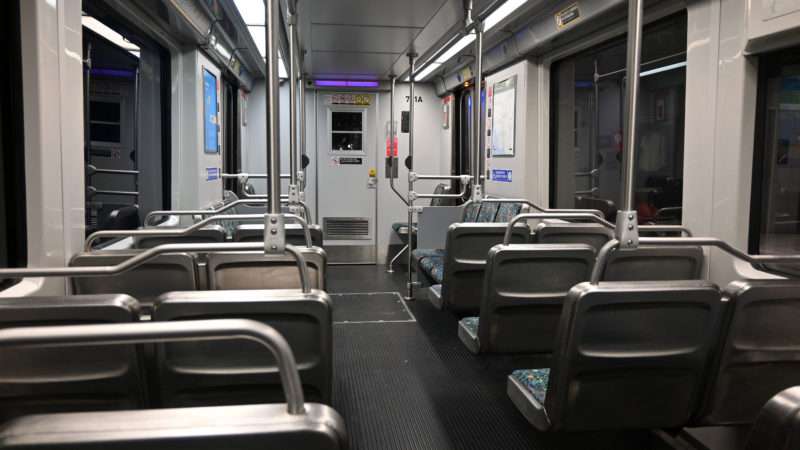
The Los Angeles County Metropolitan Transportation Authority, called Metro for short, will convene a taskforce this week to study the idea of abolishing fares on its buses and trains.
The aim is to boost ridership and support low-income riders who’ve been hit hard by the coronavirus pandemic. Still to be determined is how the already financially strained Metro would cover the costs of making its service free to riders.
“Metro has a moral obligation to pursue a fareless system and help our region recover from both a once-in-a-lifetime pandemic and the devastating effects of the lack of affordability in the region,” Metro CEO Paul Washington told The Source, Metro’s blog.
The idea has earned the support of L.A. Mayor Eric Garcetti, who chairs Metro’s Board of Directors. Garcetti said on Twitter that abolishing fares would be “an important step toward a more equitable and sustainable future.”
The Source post notes that the median Metro rider’s household income is $17,975 for bus riders and $27,723 for rail passengers, two income brackets that have been hit hard by the health and economic impacts of coronavirus.
Eliminating fares for all riders, regardless of income, would be an expensive proposition.
In fiscal year 2019, Metro says it pulled in $250–$300 million in fares to cover $1.9 billion in operating costs. In 2018, Metro collected $300 million in fares from its bus and rail services, which covered just under 20 percent of its operating expenses.
The money that Metro would lose from eliminating fares come on top of the extra costs it has had to assume because of the pandemic, says Baruch Feigenbaum, a transportation expert at the Reason Foundation (which publishes this website).
“To carry the same number of folks, they have to run extra trains, because they’re trying to do some form of social distancing. They have added health costs for their employees,” says Feigenbaum. “Ridership is going down and costs are going up, and you’re saying: ‘Let’s just get rid of one of our major revenue sources.'”
Metro estimates that it’s facing a $1.8 billion funding shortfall because of the pandemic. The Coronavirus Aid, Recovery, and Economic Security (CARES) Act including $25 billion in federal grants to distressed transit agencies; Metro received $861.9 million of that.
The California Transit Association, of which Metro is a part, is asking for an additional $3 billion this year to cover local transit agencies’ pandemic-related losses.
Metro says that it would study other sources of revenue to cover the costs of lost fares, including state grants, federal grants, and more advertising.
Asked whether it would cover the costs of fare abolition with tax increases or service cuts, a Metro spokesperson tells Reason that “we are not considering tax increases and have the ability to adjust our service levels now to meet on-street realities.”
Feigenbaum argues that eliminating fares weakens Metro’s incentives to keep costs under control. “As long as [riders] are paying some cost, there’s still some incentive to keep costs down,” he tells Reason, given that higher costs will have to be reflected in fare prices. “If you get rid of the fare altogether, there is no incentive whatsoever.”
The past few decades have seen Metro prioritize expanding light rail service frequented by higher-income “transit choice” riders, while cutting bus services normally used by lower-income “transit-dependent” riders. If riders aren’t expected to cover any of the costs of their rides, Metro would one less check on its tendency to build pricey but little-used rail lines at the expense of more heavily used bus lines, Feigenbaum points out.
Transit-dependent riders themselves report valuing service improvements over the elimination of fares.
“Most low-income bus riders rate lowering fares as less important than improving the quality of the service,” the Transit Center found in a 2019 survey of 1,700 riders from 7 cities. “This suggests that if a transit agency had to choose between devoting funds to reducing fares or to maintaining or improving service, most riders would prefer the latter.”
That same survey says that Los Angeles, given its low farebox recovery ratio, would be best placed of any large transit system to eliminate fares. But it also concludes that other policies, such as congestion pricing or higher parking fees, would do a better job of increasing transit ridership and improving transit service.
Studies of fare-free transit find that the idea works best when adopted by smaller cities, such as college and resort towns, where the costs of fare collection are high compared to revenue taken in and where transit systems have enough capacity to absorb new riders.
Denver and Austin both abolished fares in the 1970s only to reinstate them later. The abolition of fares, coupled in both cases with expanded service, did increase ridership, according to a 2012 study. But it also generated overcrowding on vehicles and an increase in “problem passenger” incidents. The Kansas City Council voted last year to make public buses fare-free but it has yet to implement the system. A sticking point, reports Smart Cities Dive, is finding the $8 million needed to cover the cost of ditching fares.
Feigenbaum suggests that fare vouchers for low-income riders, funded by higher fares for less price-sensitive transit users, would be a better approach than abolishing fares entirely. That would help subsidize riders who need transit while forestalling the need to hit up taxpayers for additional revenue.
from Latest – Reason.com https://ift.tt/3gK49Dy
via IFTTT